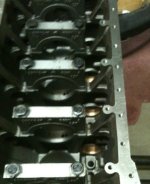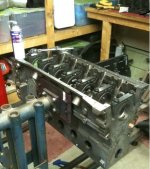Roller is not always better for our particular applications. When you graph valve lift as a function of crank angle rollers don't always look as good. In a most instances unless you are going with some really high duration, high lift profiles, in my opinion flat tappets are superior.
Another thing to look at is just because you have a roller tip on the lifter does not equate to less friction in the valvetrain. Less friction on the lifter face yes, but when you look at the side loading of the lifter in it's bore in most instances there is greater overall friction in the system. A lot of that depends on how much the lifter comes out of the bore which is dependant on the size of the base circle. The more the lifter comes out of the lifter bore , the greater the fulcrum action, side loading of the lifter bore and tendency to mushroom the base of the lifter bore.
I was in a meeting with a bunch of motorsport engineers, many in the camshaft industry a month or so back. I heard story after story of increased oil temps when roller lifters were used. This can be explained by nothing other than increased friction due to lifter sideloading. Even with the decreased friction of the roller tip.
When sideloading, and slower initial ramp rates are factored in, rollers are not always the best choice.
Zach



